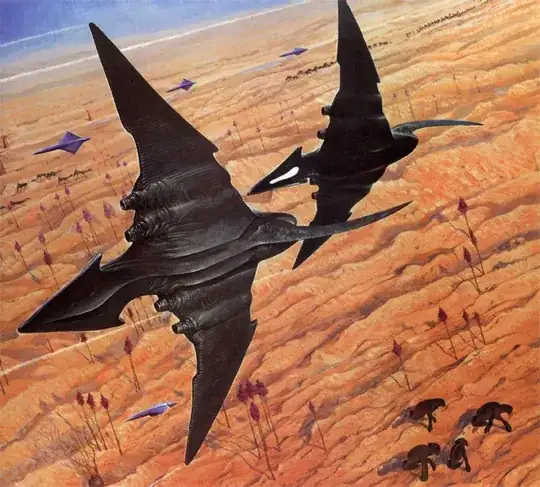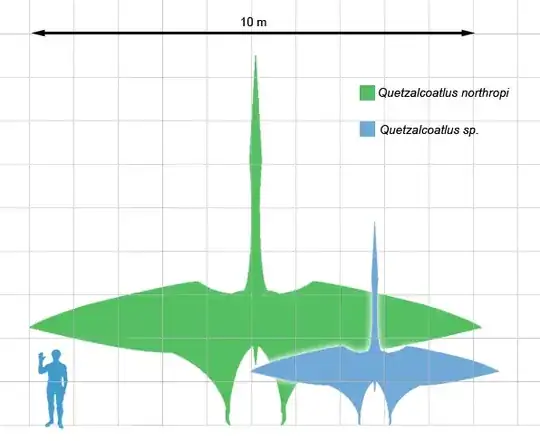I'm always amazed by how people forget/don't know about pterosaurs in such discussions about giant flying animals, only one person commented on them. Pterosaurs are the most amazing thing the earth has produced, they need more attention. There are a lot of misconceptions about them, it is pretty consensus in the field that even the biggest were capable of flight and they have biomechanical models and simulations to back it up, we have a great idea of how they did it, though the research is new - I would argue that we might understand pterosaur flight better than insect or bird flight (maybe even bats) which are much more complicated ways to fly.
I mean, before planes and pterosaurs, people thought birds were the heaviest thing capable of flight, if nobody had ever seen a flying animal I'm pretty sure they would think flight was impossible in the first place. Early naturalists often said the elephants were pushing the limits of animal size, scientists said animals couldn't survive extreme heat or pressure, etc and etc. Time and time again, those bold affirmations are proven wrong.
Yes, it is pretty possible for a flying creature to lift a human being. See that article by paleontologist Mark Witton:
https://io9.gizmodo.com/what-would-life-be-like-if-pterosaurs-were-alive-today-5909172 -> The article goes on more detail of the challenges.
Although, it would probably have to be a light human, not a heavy weight boxer or fat guy. But even so, if those animals could lift a human being, some more adaptations on top of the ones they already posses and you could lift a larger cargo, maybe his bones are some kind of very strong and light carbon based material of fiber, stronger muscles, a more efficient breathing system, maybe with large airholes like the ikrans of avatar, use of myoglobin instead of hemoglobin, etc. Small things make a huge difference.
The hardest part is not for a flying creature to lift a human being, the hardest parts are:
- For the human to resist the coldness and rarefied air of higher altitudes, it would probably have to wear some gear or the humanoid itself would have to evolve for it, the Sherpa people of Tibet have interesting adaptations to survive high altitudes that they took from inbreeding with other ancient hominid race, it would be interesting to take a look at it;
For the creature to be a hexapod like you want, with four legs and two wings. That doesn't exist on earth, the closest thing I can think of are:
1) Insects, but they have problems getting that big in the current
atmospheric conditions (although if an insect developed pulmonary
respiration and air sacs that's hard to predict how big they could
get). The dragonflies the people of Krypton fly in Man of Steel are a good example.
2) A wing that evolved through something like a gliding lizard. The draco volans couldn't really do it since it's wings come through the ribs bones and can't develop into another member, but there was an extinct variety called coelurosauravus who developed new bones for a wing membrane, not part of the ribs. Given enough time, evolutionary pressure and lack of competition from better flyers they could eventually develop something similar to a whole other limb used for flight. Now, this would be really problematic, since animals with extra limbs usually suffer to provide blood and energy for them, specially wings that are really energy consuming. You could get away by giving then some strange and efficient vascular and respiratory system, as I've already proposed, maybe even other auxiliary small hearts.
But, if you really want feathered wings it would be problematic since feathers can't carry as much cargo as a wing membrane. You could easily get away by saying the animal has a wing membrane that do the work and a coat of feathers above for insulation, pterosaurs probably have some simple feather-like structures that did it, and many dinosaurs developed somewhat complex feathers even though they didn't use them for flight, your animal could use them to help create turbulence or make the flight quieter or even for display, but it would be the wing membrane that would have to do all the heavy lifting - Take a look at the dinosaur Yi Chi for inspiration who also had feathers and a membranous wing.
But I don't feel like the biomechanics of flight are really the meat of your question, you wanna know what makes a good animal for domestication. CGP Gray has amazing videos about it:
https://www.youtube.com/watch?v=JEYh5WACqEk
https://www.youtube.com/watch?v=JEYh5WACqEk
You should think if the creature needs to be domesticated, it might just be tamed, which have lower requirements. On the other side, domestication could help explain how they became such good flyers, maybe they've being selective breeding and are much better flyers than their natural counterparts, I'm assuming genetic engineering to be out of question. Regardless, it would be pretty hard to tame a large flying animal. They might create them from birth and start behavioral training young. It would help if the creature was a herbivore without much to fear in the wild, and was already social with hierarchical structures and high intelligence. Maybe some imprinting could help. Needless to say they would have to train the creature tethered to the ground and use safety belts and parachutes/wingsuits for safety. Once they tamed the first ones they could use the more experienced ones to help train the new ones, so more experienced flyers could help in rescue if some accident happen, so overall I think training then might not be the hardest part.
Good luck in your world!
Edit: Came back after some thoughts, your question really got me thinking, it was the reason I've created an account in the first place. Forgot to mention other problem about wings on the back. That is that you would basically have a lot of extra weight having to carry that much members that aren't really necessary. One of the advantages of pterosaurs that made them reach such huge sizes was their quadrupedal launch that makes them use their strong wing muscles on flight and on take off (one of many, you should really research pterosaurs adaptations) and don't need such strong leg muscles. You could have a two wings, two legs animal that still walk on four like pterosaurs and have feathers.
Like that: https://in.pinterest.com/pin/765400899152037936/?nic_v1=1ahBmj9kCSbnUq%2BdkdNiWjIkSorZaTrBxBfhXYWu4hUqCZHtMpngpGTl%2FzqMoRj1n%2F
But the more important thing is to grant the creature a real ecology, and specially create a place were they have the sufficient calories and reasons to fly (like predators to escape or foods to access). The creature can develop as much crazy features as you want if it servers a real niche and it has enough calories available to do so (and don't have competition from better flyers with less crazy and more efficient body plans doing the same work). To power wings on the back in such a big creature would require enormous caloric power, maybe they co-evolved to eat big fruits that need them to disperse seeds or maybe there are some really massive flowers of a sequoia sized plant producing a ton of really high caloric nectar that they eat like a hummingbird (keeping the idea of them being herbivores and also without needing large and heavy stomachs to process leafs that are really very low in caloric density) and they're the only ones exploring that food source. Evolution doesn't mean only the most efficient animal possible survive, there are some animals that should already be extinct if it wasn't for their ability to explore a very specific food source that only they can get, sexual selection can also help explain why they retained characteristics like four limbs and feathers, animals really push the limits of evolution to please a partner. That and also selective breeding of species people culturally thought were aesthetically pleasing.
Other forms of flight like jet propulsion aren't really energy efficient, balloon creatures would have to be enormous to be able to lift their own body and a person, so they would look more like flying houses than flying mounts. Anything smaller than that and storing so much gas is much more trouble for a very little difference in their weight.
All of that of course, thinking on a very earth-like environment, any change to atmosphere density, oxygen levels and planet gravity would already make a huge difference.

